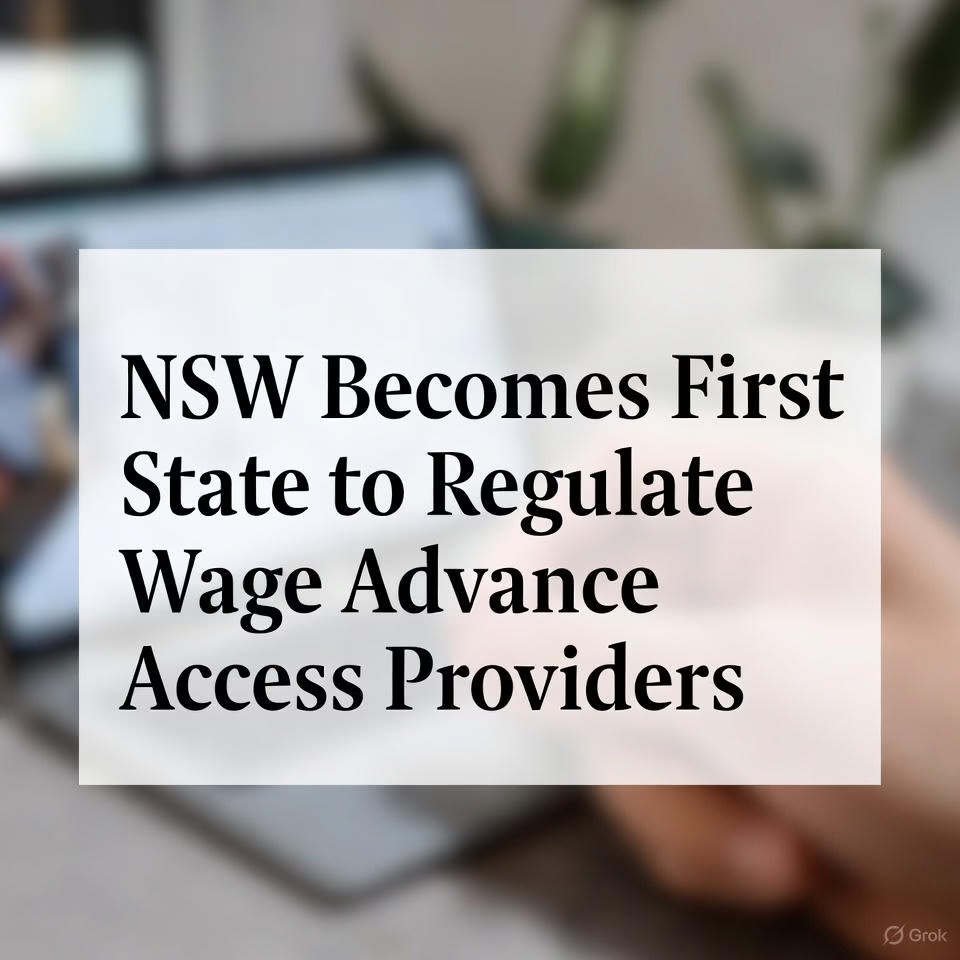New South Wales’s regulation of wage advance access providers is a significant step in the country’s changing financial services environment. By doing this, NSW sets the stage for national regulatory reform by being the first jurisdiction to formally oversee the industry.
After Buy Now, Pay Later guidelines were introduced in June 2025, salary advance access products have been the latest focus of financial regulation, drawing increasing scrutiny from consumer advocacy groups. These services give workers temporary financial flexibility by allowing them to take out a portion of their earnings prior to payday. Regulators are worried about their operations in a legal “grey zone,” meanwhile, where traditional consumer credit protections have not been implemented.
Rapid Growth in an Unregulated Market
The wage advance sector has experienced substantial expansion across Australia. This mirrors international trends where earned wage access products provided approximately $31.9 billion to 10 million workers in 2022. Two distinct models have emerged in the Australian market. Employer-integrated platforms coordinate directly with workplace payroll systems. Direct-to-consumer services connect to users’ bank accounts to estimate earnings.
Usage patterns reveal troubling frequency rates. Research indicates employer-sponsored platforms see users accessing funds 10 to 27 times annually. Direct-to-consumer models show even higher engagement at 26 to 33 transactions per year. These figures suggest many Australians have integrated wage advance access into their regular financial management strategies. They’re not using these services solely for emergencies.
The regulatory gap becomes particularly problematic when examining provider obligations. Unlike traditional credit products governed by the National Consumer Credit Protection Act, wage advance services currently face no mandatory requirements. There are no rules forcing them to assess affordability or provide hardship assistance. Formal dispute resolution mechanisms are also absent.
Financial counselling organisations report increasing caseloads involving wage advance debt. Some clients present with multiple concurrent arrangements. This creates compounding fee structures that effectively reduce take-home pay. The debt cycle phenomenon mirrors patterns previously observed with unregulated Buy Now Pay Later products before legislative intervention.
Learning from the BNPL Precedent
The regulation of Buy Now Pay Later services commenced on 10 June 2025. It established a legislative framework potentially applicable to wage advance products. The Treasury Laws Amendment (Responsible Buy Now Pay Later and Other Measures) Bill 2024 introduced a new category of “low cost credit contracts.” This was specifically designed to capture emerging financial products that previously exploited definitional loopholes in credit legislation.
The Bill’s explanatory memorandum explicitly referenced wage advance as a product type that could be regulated under the expanded framework. This acknowledgment validates consumer advocates’ arguments. Wage advance access fundamentally constitutes credit despite industry claims otherwise.
The BNPL regulatory model imposes several key requirements relevant to wage advance oversight. Providers must obtain Australian credit licences through ASIC. They must conduct appropriate affordability assessments and provide clear fee disclosure. They must also participate in external dispute resolution through the Australian Financial Complaints Authority. Modified responsible lending obligations apply based on transaction size.
What Consumer Protection Would Deliver Affordability Assessment Requirements
Mandatory affordability checks would require providers to verify that users can reasonably meet repayment obligations without experiencing substantial hardship. This assessment must consider existing financial commitments and living expenses. It must also factor in income stability. Current arrangements typically lack such screening. This leads to unsuitable lending where advances exceed users’ realistic repayment capacity.
Fee Transparency and Caps
Regulation would mandate clear disclosure of all fees and charges before contract formation. Fee caps similar to those applied to small amount credit contracts could prevent excessive charges. These accumulate when users access multiple advances. Some Australian providers currently charge 5% transaction fees plus annual interest rates reaching 24%. This creates significant costs for frequent users.
Hardship Provisions
Licensed credit providers must offer hardship assistance when borrowers experience changed circumstances. This obligation includes payment plan modifications and fee waivers. It also includes collection activity restrictions. Users of wage advance services currently have no statutory right to such support. This leaves them vulnerable during financial stress periods.
Dispute Resolution Access
AFCA membership would provide users with free and independent dispute resolution services. These cover complaints about lending practices and fees. They also address collection activities. This external oversight mechanism helps address power imbalances between individual consumers and financial service providers.
Industry Adaptation and Market Evolution
Financial service providers operating in the wage advance space face potential operational changes under expanded regulation. Compliance costs include licensing application fees and ongoing ASIC supervision levies. System upgrades for affordability assessments are also necessary. Staff training on responsible lending obligations adds to these expenses.
Some industry participants argue these costs may reduce service accessibility. They suggest fees for end users might increase. However, consumer advocates counter that business models relying on regulatory arbitrage should not receive protection at the expense of consumer welfare.
Market consolidation appears likely if regulation proceeds. Smaller operators lacking resources for compliance infrastructure may exit. Larger providers or those backed by established financial institutions may gain market share. Platforms like Loan Owl that already prioritise responsible lending practices may find themselves better positioned in a regulated environment.
The employer-sponsored segment faces particular complexity. Many workplace programs operate as employee benefits with minimal fees. Regulatory frameworks must distinguish between genuine employer-facilitated early pay access and third-party products marketed through workplace channels. The latter typically carry higher costs and greater risks.
Alternative Financial Solutions
No Interest Loan Schemes
Community organisations across Australia provide small loans typically ranging from $800 to $1,500. These are for essential goods and services without fees or interest charges. These schemes specifically target low-income households. They represent genuinely cost-free alternatives to wage advances for one-off expenses.
Employer Direct Programs
Progressive employers increasingly offer early wage access as an integrated payroll benefit. When structured appropriately with minimal fees and usage limits, these arrangements provide employees with flexibility. They avoid third-party profit extraction. Loan Owl’s approach to early pay access demonstrates how providers can deliver services with enhanced transparency around costs and terms.
Centrelink Advance Payments
Eligible benefit recipients can access advance payments for genuine emergencies. This provides up to several weeks of payments upfront. While this reduces future payments, it avoids the fee structures associated with commercial products.
Financial Counselling Services
Free financial counselling through services like the National Debt Helpline (1800 007 007) helps individuals develop sustainable budget strategies. Counsellors can negotiate with creditors and access emergency relief. These services report increasing demand correlated with cost-of-living pressures affecting Australian households.
Policy Outlook and Implementation Timeline
The regulatory momentum favouring wage advance access oversight appears strong. Consumer advocacy coalitions have presented unified positions to the government. Treasury’s existing legislative framework through the low cost credit contract provisions provides a ready mechanism for expansion. This doesn’t require entirely new legislation. Regulations could be amended to explicitly capture wage advance products. This is similar to the path taken for BNPL oversight.
Implementation timelines remain uncertain. BNPL regulation required nearly a decade of advocacy before legislative action. Consumer groups emphasise the urgency of faster intervention. They point to documented harm already occurring and lessons learned from the BNPL delay.
ASIC has signalled heightened attention to emerging credit products through recent enforcement actions. The regulator’s supervisory priorities emphasise that consumers who access these products are often financially vulnerable. They warrant robust regulatory protection.
Risk Mitigation Strategies
Until comprehensive regulation takes effect, Australian consumers using wage advance services should exercise caution. Implementing protective strategies is essential.
Carefully review all fee structures before using any platform. Calculate the true cost of advances including transaction fees and interest charges. Also factor in subscription costs. Compare these expenses against alternatives like small personal loans. This helps identify the genuinely lowest-cost option.
Monitor usage patterns to prevent dependency cycles. If accessing services more than monthly, underlying budget issues likely require attention. Financial counselling offers better solutions than continued borrowing against future income.
Verify provider credentials and complaint handling procedures. While formal regulation remains pending, reputable providers typically operate with greater transparency. Consumer-focused practices distinguish them from less established platforms.
Document all transactions and communications with providers. Should disputes arise, comprehensive records strengthen your position. This helps when seeking resolution through provider internal processes.
Conclusion: Balancing Innovation and Protection
Australia’s wage advance sector sits at a regulatory crossroads. These products can serve legitimate purposes in helping workers manage short-term cash flow challenges. However, the absence of consumer protections has enabled harmful practices. These trap vulnerable Australians in debt cycles.
The BNPL regulatory precedent demonstrates that innovation and consumer protection need not be mutually exclusive. Appropriately calibrated oversight can preserve access to useful financial tools. It can also eliminate exploitative practices and ensure adequate safeguards.
The fundamental question remains straightforward. Should products functioning economically as credit receive the same regulatory treatment as other credit? This applies regardless of their marketing language. Regulatory momentum suggests agreement with that position.






